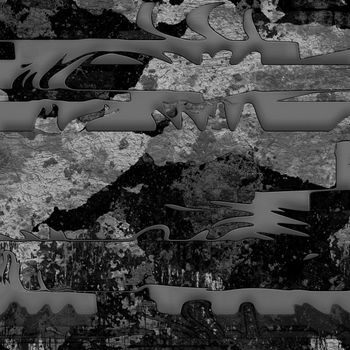SAAL3 is a short performance format created to give artists the opportunity to experiment, try things out, make mistakes and successful attempts. SAAL3 takes place on only one evening – making the event both a premiere and a finissage at the same time. The artists of SAAL3 vol 4 are Viktoria Martjanova, Mihkel Maripuu, and Norman Orro.
The lineup for SAAL3 vol 4 was selected by Emer Värk, a freelance visual artist whose work spans from theatre stages to television screens and the heart of events. He described the starting point of his choices as follows: “The goal of SAAL3 is to bring sensations to the stage and to offer the stage to people who are engaged in creating such worlds. Often, the work of visual artists plays a supporting role in performing arts pieces, but on this evening, it will be possible to experience their work at the center. For some artists, there is no direct connection to the performing arts, yet their practice holds great potential for performativity.”
Viktoria Martjanova "best version"
The performance deals with an identity crisis related to cultural belonging – the complexity of being between languages, culture, and self-definition. It explores collective experience, personal memories, human connection, and the influence of society on the formation of identity. One language can become a shadow, a weapon, and a home, while another may be one’s own, beloved, yet untamable – between these feelings, a complex knot of uncertainty is born.
tiny, tiny little one.
you can’t chance anything, or influence anything
be there and silet and afraid
little silent wordless one
until i offer you words
be afraid and silent little one
Viktoria Martjanova is a young multidisciplinary artist who primarily works with space as living material, as well as with sound and video in various forms. Her focus lies on the processes of creating art, their catastrophic nature and catharsis, as well as on the boundaries between the artist and the viewer in their shared understanding. Her personal theory approaches the experimental method as a safe and anti-catastrophic way of creating. Her works have been presented at the Performa Biennial in New York, at Raw and Alma Gallery spaces in Riga, and at Vilnius Art Week. She is also the recipient of the Young Artist Award at TASE 2025.
Mihkel Maripuu "X"
Performative crossroads mythology represents a liminal state and a symbolic system in which restless or homeless spirits meet – beings and forms of existence in a state of transition. The crossroads, as a mythological and ritual space, signify a condition where the boundaries between the past and the future, the visible and the hidden, the real and the imagined become blurred and merge into a new layer of experience.
In this space, magical and ritual acts can be performed through which identities and relationships of belonging are created or transformed. The crossroads function as a liminal zone where worlds overlap and opposing categories – life and death, presence and absence, self and other – lose their clear distinctions.
Performative crossroads mythology is expressed as a ritual act that is symbolically charged and opens up the possibility of approaching identity, separation, and transition not as fixed states but as dynamic and shifting processes.
Such an approach makes it possible to understand the dialectic of belonging and separation not through opposites, but through continuous fluidity and reinterpretation. Crossroads mythology thus signifies not only a meeting place between worlds, but also a performative practice that generates new meanings and forms of existence within the context of liminality.
Mihkel Maripuu is an artist whose practice is characterized by a multidisciplinary approach that integrates various media, encompassing not only the visual but also sonic and physical platforms. In his work, he explores the distinctions between technology and the organic, as well as the overlapping principles of their potential common grounds — examining how digital systems and biological structures share similar rhythms, patterns, and dynamics. His practice addresses questions of identity, materiality, and the interplay between environment and technology in a new and era-specific way. Maripuu’s works raise the question of how human experience is shaped through the interweaving of technological and biological realms, opening a dialogue toward hybrid existence.
Norman Orro "Vox Aevum"
Let’s take a moment, slow down and discover new sounds.
Can humans or machines make music alongside humans? Perhaps we unknowingly form a shared cultural space with nature – an ecosemiosphere, where fragments of melody bounce back and forth, transforming as they go? One thing is certain – through the jungle of the future, we cut our path not with a machete, but with a flute! Which way are you going, western man?
Norman Orro is a musician and artist whose interests meet at the intersections of humanity, nature, and technology. By intertwining various media with speculative narratives, he questions the dominance of technocentric stories and seeks to bridge the gap between nature and culture. The interplay of semantic and atmospheric signals in his work carries a subtly uncanny yet utopian tone.
Since 2010, under his project Music For Your Plants, Orro has created conceptual albums, visual essays, and installations. Within this framework, he has designed the soundscape for the Chinese Pavilion at the 56th Venice Biennale and performed at Creepy Teepee and Boiler Room. He has also contributed to internationally recognized publications such as DIS Magazine (USA), NXS World (Netherlands), and Ofluxo (Spain). His work has been exhibited in Italy, France, Germany, the Czech Republic, and Denmark.
